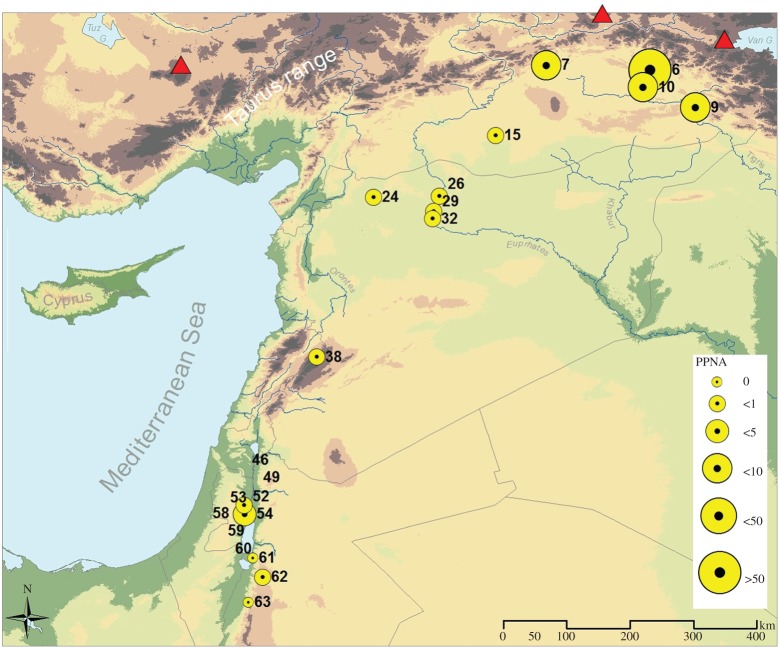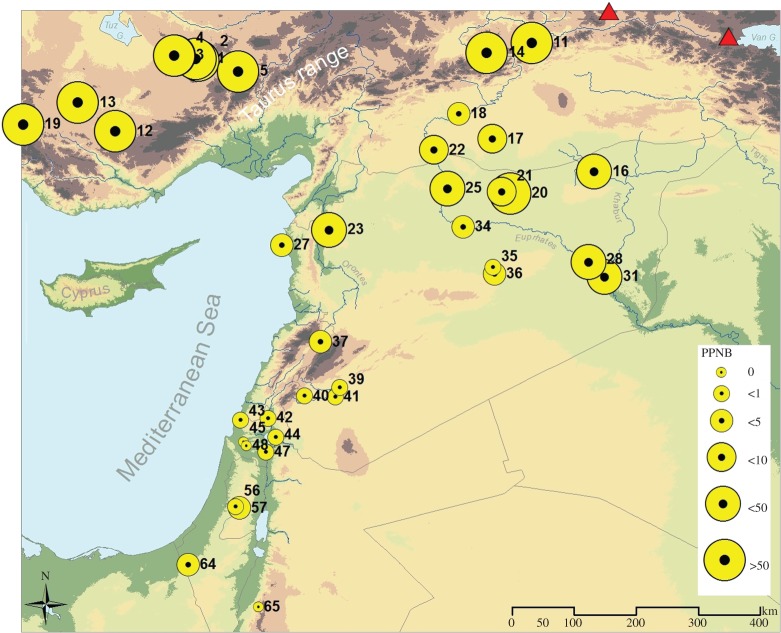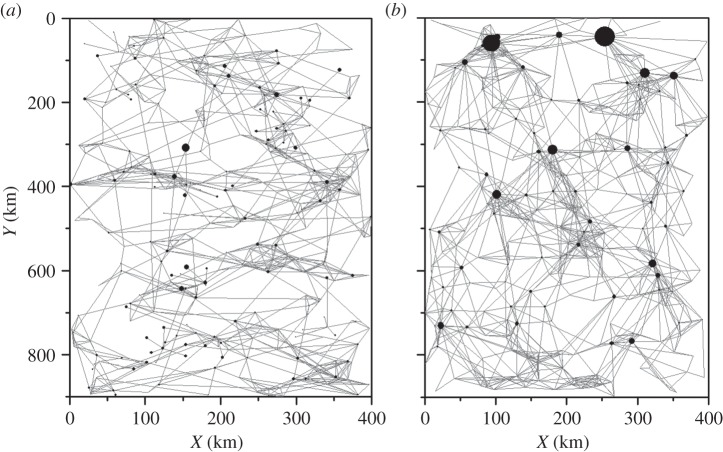Abstract
In this paper, we explore the conditions that led to the origins and development of the Near Eastern Neolithic using mathematical modelling of obsidian exchange. The analysis presented expands on previous research, which established that the down-the-line model could not explain long-distance obsidian distribution across the Near East during this period. Drawing from outcomes of new simulations and their comparison with archaeological data, we provide results that illuminate the presence of complex networks of interaction among the earliest farming societies. We explore a network prototype of obsidian exchange with distant links which replicates the long-distance movement of ideas, goods and people during the Early Neolithic. Our results support the idea that during the first (Pre-Pottery Neolithic A) and second (Pre-Pottery Neolithic B) phases of the Early Neolithic, the complexity of obsidian exchange networks gradually increased. We propose then a refined model (the optimized distant link model) whereby long-distance exchange was largely operated by certain interconnected villages, resulting in the appearance of a relatively homogeneous Neolithic cultural sphere. We hypothesize that the appearance of complex interaction and exchange networks reduced risks of isolation caused by restricted mobility as groups settled and argue that these networks partially triggered and were crucial for the success of the Neolithic Revolution. Communities became highly dynamic through the sharing of experiences and objects, while the networks that developed acted as a repository of innovations, limiting the risk of involution.
Keywords: network theory, complex networks, neolithization, Near East, obsidian exchange
1. Introduction
It has been hypothesized that social networks were especially relevant during the most dynamic periods of human and societal evolution [1]. Innovations were likely to be an emergent property of new modes of interaction affecting many different individuals, rather than a consequence of the creativity of a few. Through the quantitative analysis of obsidian exchange, we demonstrate how this interpretation—originally applied to the Industrial Revolution [2]—is equally applicable to the Neolithic Revolution in the Near East, when the last groups of hunter–gatherers shifted to a sedentary way of life, becoming farmers.
In human societies, intergroup social interaction is often associated with the exchange of valuable and commonly exotic objects [3]. The analysis of the presence of this kind of object allows intergroup relationships to be quantitatively studied. Obsidian was a valued commodity exchanged at long distances in the Neolithic Near East and the analysis of its exchange during this period permits us to study the inner workings of early interaction networks.
The neolithization process took place in an extended region of the Fertile Crescent, comprising Mesopotamia, the Taurus and Zagros Mountains and the Levant. From 12 000 to 10 000 BC, the last hunter–gatherers began to have more sedentary lifeways, gradually acquiring forms of economic and social complexity. During the Pre-Pottery Neolithic A (PPNA; 10 000 to 8500 BC), the first Neolithic villages appeared in which the first experiences with plant cultivation occurred. In the Pre-Pottery Neolithic B (PPNB; 8500 to 7000 BC), the first animal and plant domesticates are documented. By the end of this period, domesticates prevail over wild resources in the everyday lives and diets of PPNB societies. Obsidian begins to appear on Near Eastern sites at extremely long distances from its origins, starting with the onset of the Neolithic. This material, whose exploitation and exchange were inextricably tied to the Neolithic period, therefore acts as both a quantitative tool for modelling human networking, as well as providing one direct perspective on the mechanisms that drove the course of the Neolithic in this part of the world.
2. Obsidian exchange
Obsidian from central and eastern Anatolia was exchanged at very long distances across the Fertile Crescent during the early stages of the Neolithic [4–10] (figures 1 and 2) and was predominantly used for making tools. During the PPNA, this volcanic stone was employed to make the same kinds of tools as those made from flint: projectile points for hunting, knives for cutting different materials, endscrapers to soften hides, etc. During the PPNB, obsidian was employed for making a variety of tools in areas where the material was dominant, while in areas where it was rare, small and sharp blades mainly used for cutting soft animal tissue were made, using a new technique (pressure flaking). This technique ensured a maximum production of standardized tools from the material, a strategy advantageous faced with small amounts of material or with a demand for efficient production. Programmes dedicated to obsidian source characterization have provided the geological and archaeological data needed to match obsidian artefacts to specific sources [11–15]. Alongside associated chronological indicators at a number of sites, these datasets allow us to model early exchange systems in the Near East. Most models used to explain the mechanisms of obsidian exchange are based on the down-the-line model proposed by C. Renfrew in the 1960s [16]. By compiling mainly Near Eastern and Mediterranean obsidian data, Renfrew observed that there was a monotonic diminution in the quantity of obsidian with distance from the source of origin. This led to the formulation of a model of down-the-line exchange, where one part of the obsidian available at one village was used locally for making tools, while the rest was transferred to a neighbouring village [16].
Figure 1.
Map of obsidian distribution in the Near East during the PPNA. The triangles indicate the sources of obsidian. (Online version in colour.)
Figure 2.
Map of obsidian distribution in the Near East during the PPNB. The triangles indicate the sources of obsidian. (Online version in colour.)
Although Renfrew's theory is still used to explain obsidian distribution in the Near East and exchange systems in many other prehistoric contexts [17], its capacity for elucidating the complexity of Neolithic Near Eastern interaction networks is limited [18]. We can demonstrate this by mathematically replicating this model and running different variables. In using a fixed ratio of obsidian consumption for each village, the quantity of obsidian available for exchange declines drastically after a few exchange events. For example, using a 50% rate of consumption/exchange of obsidian per village, quantities of obsidian decrease to 0.39% after eight exchange events. However, if we bear in mind that quantities of obsidian with respect to flint are around 0.5% on sites in the southern Levant that are at distances between 700 and 800 km from Anatolian outcrops, then in order for the down-the-line model to fit the archaeological data, Neolithic villages would have had to be 100 km from one another. Furthermore, archaeological surveys carried out in recent decades demonstrate that the Near East was more densely populated during the Neolithic—especially during the PPNB—than is accounted for by such a model. Very low ratios of obsidian consumption in each village and high ratios of obsidian transfer (i.e. 10% versus 90%) are another means of making this model viable. In this hypothetical scenario, the exchange value of obsidian would have been much greater than its use value. However, most of the obsidian remains are recovered from archaeological sites in the form of used and discarded tools. The use value of this material was therefore of great importance. In fact, obsidian caches, which could have represented material ready for exchange, are extremely rare in the archaeological record [19]. Moreover, if obsidian predominated as a commodity for exchange at the onset of the Neolithic, larger quantities of obsidian would be observed at the margins of the Levantine corridor (i.e. in the southern and eastern extremities) where trade was probably less intensive, and where obsidian's use value was higher than its trade value.1 This is certainly not the case archaeologically. The down-the-line model becomes inapplicable to the case study when the most realistic2 variables are used, and especially with respect to the ratio of consumption/exchange per village and distance between villages. An alternative model of obsidian exchange and interaction network is therefore needed.
3. Complex networks of obsidian exchange
Obsidian exchange can be studied as a network whereby nodes are constituted by sedentary villages joined by exchange links. Network theory (NT) can be a source of alternative models to the down-the-line exchange model [22–25]. In NT, it is acknowledged that in addition to simple networks which are purely regular (each node is connected to all its neighbours) or purely random (each node is randomly connected to any other node), other complex networks existed where nodes were connected to their neighbours while certain other nodes were also linked to distant nodes (figure 3), showing non-trivial topological features.3 Watts & Strogatz [25] established that networks are defined by path length L(p), the property measuring the mean separation between two nodes, and by clustering coefficient C(p), measuring the degree to which agents tend to group together in local neighbourhoods. Path length L(p) involves the number of nodes an agent needs in order to cross the network. Path length is therefore not related to a physical distance but to the number of steps made. Clustering coefficient C(p) measures to what extent nodes are preferentially linked to their near neighbours (nearest nodes) rather than to distant nodes. This is measured by the proportion of links that really exist between nodes within a neighbourhood, divided by the number of links that could possibly exist between them.
Figure 3.
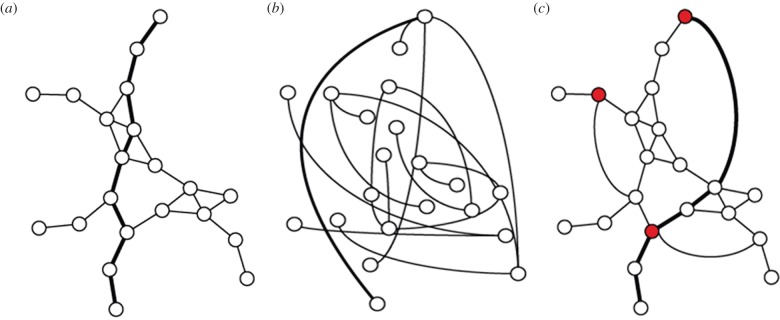
(a) Regular network, (b) random network and (c) complex network. The red points indicate the nodes with distant links. (Online version in colour.)
Regular networks (figure 3a), where each node connects to all of its nearest neighbours and all the nodes show a similar degree of connectivity, show a high clustering coefficient and a high mean path length. In random networks (figure 3b), any node can connect randomly with any other node irrespectively of the number of nodes existing between them. Such networks show a low mean path length and a low clustering coefficient [25]. Complex networks (figure 3c), which are present in a great variety of natural and social systems [24,25], lie midway between regular and random networks. In these networks neighbouring nodes are interconnected forming local clusters, but some of them are also able to interact with distant nodes by establishing shortcuts. For our case study, the down-the-line model can be assimilated to a regular network, as villages are connected to their neighbours and there are no distant exchange links. Regular networks show strong neighbourhood connections (high clustering coefficient). This offers a plausible scenario for our case study, as the preferential linkage of villages in local clusters is common in the ethnographic literature on exchange systems between sedentary farming communities [26–31] and applicable to a Near Eastern Neolithic context. However, the high path length implies that a long and circuitous route passing through many intermediate nodes is required to reach distant nodes. As obsidian quantity decays drastically in every exchange step, a regular network model (such as the down-the-line model) showing high path length would not have allowed obsidian to reach the large distances attained in the Neolithic. Therefore, regular networks resulting from the down-the-line model are not appropriate for our case study.
In random networks, distant nodes are easily interconnected and few nodes have to be passed through to cross the network (low path length). A random network of obsidian exchange would enable the transfer of obsidian over long distances, as few exchange events would have been necessary to cross the Near East. Such a scenario fits well with the archaeological data. However, an exchange network with a low clustering coefficient is unrealistic in the case of the Neolithic Near East. Ethnographic studies carried out in pre-modern contexts have shown that preferential exchange with neighbouring communities was a common occurrence [26–28,30,31]. Moreover, a random network exchange model would result in a scenario whereby Neolithic villages exchanged with any other village without any limit in the distance between partners. This could not have been the case, as costs associated with travel/transport and with the maintenance of long-distance interactions would have limited the capacity of Neolithic villages to establish regular relationships with any other distant village.
Complex networks, where local nodes are interconnected while some nodes bear distant links, allow the interaction of distant nodes (villages) through few intermediary steps and exchange events, which results in significant quantities of obsidian reaching long distances. At the same time, complex networks show a high degree of local interaction between neighbouring villages. This results in a very efficient network as it allows for low path linking between distant zones while showing a low proportion of distant links. This is an important feature, as we can suppose that maintaining many distant exchange links would have been unaffordable for Neolithic communities in social and economic terms. Moreover, complex networks can emerge from self-organized processes whereby some form of overall order arises out of local interactions without being controlled by any specific agent. The resulting organization is wholly decentralized and very robust. In a large enough system, any individual agent can be eliminated or replaced without damaging the resulting structure [32]. This self-organized and decentralized global structure that has no documented decision-making political structures and limited social ranking fits well with the characteristics of Neolithic societies. Thus, complex networks offer appropriate templates for the modelling of the complex systems that underlie obsidian exchange in the Neolithic Near East. Such exchange models involving local transactions with neighbouring villages as well as few preferential distant trade links are ethnographically documented in New Guinea [20,21].
4. Mathematical modelling and archaeological data
To test the explanatory limits of the complex network hypothesis, we built a model of obsidian exchange (see electronic supplementary material, annexes 1 and 2) and compared the results from the simulation with the archaeological data. Mathematical modelling can be used to artificially build systems composed of interacting agents. This approach is especially useful for understanding the dynamics of complex systems, where multiple variables interact and evolve in time and space. The aim of this project is to rebuild the type of network that would have allowed obsidian to be exchanged at long distances by testing different scenarios and comparing the results of simulations of such scenarios with the archaeological data. These scenarios include the down-the-line model, which is a regular network whose simulated results do not fit the archaeological data, and two complex network models: one with distant links (DL) and one with optimized distant links (ODL). While our archaeological reasoning and knowledge of the period guide the building of such scenarios, we are required to abstract and simplify the context so as to illuminate certain possibilities before adding variables and building more complex models. Sub-regional particularities of the larger obsidian exchange network will therefore be dealt with as the modelling further develops. At this stage in the model, we are treating obsidian exchange as a homogeneous global system across the whole region in the Neolithic and are therefore applying the same rules for all of the Near East.
Villages, which are both the nodes constituting the network and the agents exchanging obsidian with other villages, were distributed in a space modelled to abstractly mimic the geography of the Near East. The evolution of obsidian quantities in each node (node = village) was computed over the course of a period of approximately 3000 steps (each time step corresponding to one annual period), so as to reproduce the real time scales for the period of interest. Local exchange links were established between neighbouring villages at a distance of 50 km (dn). Moreover, in each cycle of the DL and ODL models, some villages were randomly allowed to establish distant links with a limit in the quantity of distant links per node (1 per village) and in the distance of the link (dt up to 180 km) (figure 4). Obsidian was introduced into the network from the northern boundary of the domain and circulated along this network at a rate of 50% consumption/transfer per village. All of the obsidian produced/obtained by a village during each time step was divided into a fraction that was meant for consumption and a part that was shared between all neighbours possessing less obsidian at that particular time step with the specific fraction that was given to each neighbour being proportional to the distance between the two villages.
Figure 4.
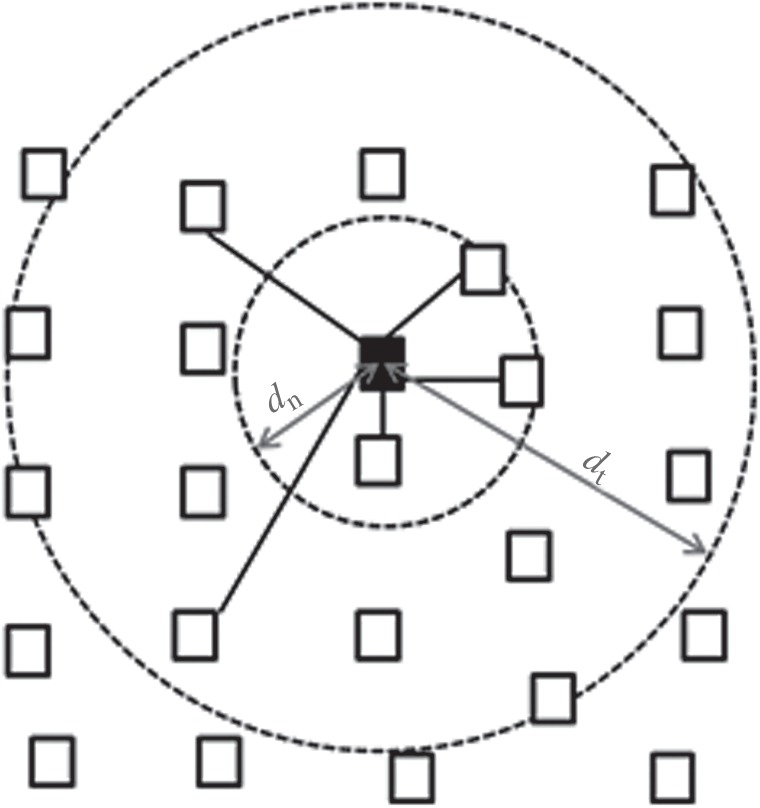
Attachment dynamics of the DL and ODL models, with the limit of the neighbourhood (dn) and the maximum limit of the distant links (dt).
Archaeological data on obsidian exchange were gathered in a database and included the proportion of obsidian with respect to flint from every PPNA/PPNB archaeological site in the study area. The ratio of obsidian to flint is an adequate measure of the quantity of obsidian consumed at any archaeological site, assuming that there was a similar consumption rate of lithic resources for tool making in each Neolithic village. In order to compare the results of the model with the archaeological data, we plotted the proportion of obsidian to flint on each site in relation to the distance from each site to the source area over the two successive Early Neolithic periods (PPNA and PPNB) (figure 5). Observation of the two resulting graphs shows a logarithmic decrement of obsidian presence and a long tail that is a product of small quantities of obsidian reaching long distances. However, some diachronic differences are noted. Higher quantities of obsidian reach further distances in the PPNB with respect to the PPNA.
Figure 5.
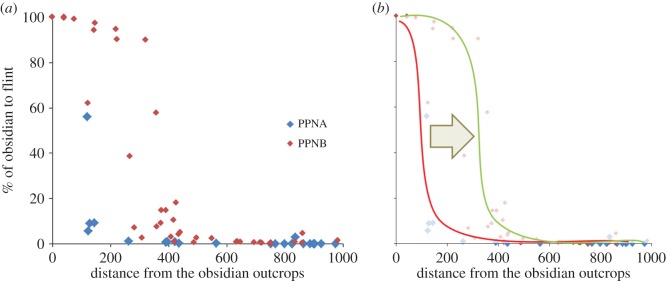
(a,b) PPNA and PPNB curves based on the archaeological data, which show the diminution in the quantity of obsidian with distance from the source of origin in each period. (Online version in colour.)
The down-the-line model (a regular network of exchange lacking distant links) shows very poor results for obsidian transfer (figure 6). The DL model, where nodes are allowed to establish shortcuts in the network by establishing distant links, generates a further distribution of obsidian. The clustering coefficient is quite similar to the regular network model, but path length is notably lower in the DL model, which demonstrates complex network properties (table 1).
Figure 6.
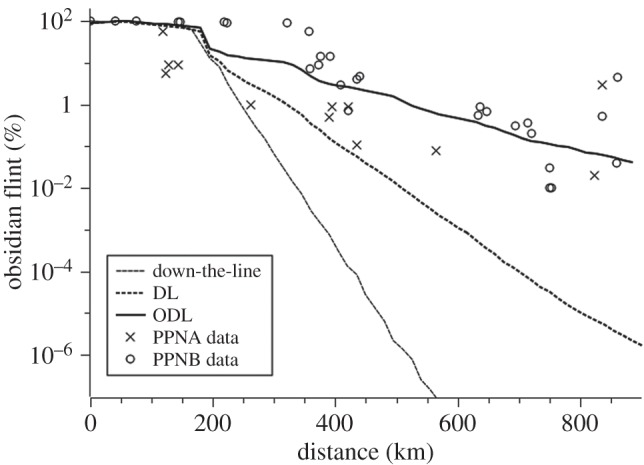
Modelling of networks resulting from the down-the-line exchange model, the distant link model (DL) and the optimized distant link model (ODL) compared with PPNA and PPNB obsidian archaeological data.
Table 1.
Clustering coefficient and path length in the three explored models of obsidian exchange compared with an equivalent random network.
| path length (number of nodes) | local average clustering coefficient | |
|---|---|---|
| down-the-line | 15.79 ± 12.65 | 0.61 ± 0.21 |
| distant link | 7.07 ± 5.88 | 0.44 ± 0.15 |
| optimized distant link | 5.10 ± 2.84 | 0.45 ± 0.16 |
| random network | 2.91 ± 1.79 | 0.035 ± 0.021 |
In comparing the results of the DL model and the archaeological data, a good match can be observed between the obsidian decay curve resulting from the modelling and that corresponding to the archaeological data for the PPNA (table 2 and figure 6). Degree distribution (measuring the number of connections of each node) of the simulated DL network that matches the PPNA data shows some heterogeneity of node degree, which can be observed in the longer tail illustrated in the histogram of the distribution of number of links per node with respect to the regular network (figure 7). This suggests the existence of an incipient site hierarchy regarding obsidian exchange. This would explain why obsidian quantities are unusually high in some Early Neolithic sites of the southern Levant [33,34], or even in Cyprus [35], as these sites would have been privileged partners in obsidian exchange networks of the period. Interestingly, as can be observed in the mapping of the degree distribution per node in the modelled space (figure 8), though the nodes with more distant links are distributed all along the modelled space they tend to concentrate in clusters. This is a phenomenon of community structure, which we will investigate further during future simulations.
Table 2.
Degree of correspondence (average individual deviation with respect to data regression) between the three models explored and the PPNA and PPNB archaeological datasets.
| average individual deviation with respect to PPNA data regression | average individual deviation with respect to PPNB data regression | average individual deviation with respect to model prediction | |
|---|---|---|---|
| PPNA data | 1.12 | ||
| PPNB data | 0.73 | ||
| down-the-line | 2.75 | 3.49 | 2.88 |
| distant link | 1.03 | 1.72 | 0.47 |
| optimized distant link | 1.38 | 1.00 | 0.22 |
Figure 7.

Frequency distribution of links per node in the three models considered in the text: down-the-line (a), distant link (b) and optimized distant link (c). Insets show the tail of the distribution at a finer scale to emphasize the corresponding differences.
Figure 8.
Examples of network configurations that emerged at the end of the simulation in the DL (a) and ODL (b) models. Links in the network are plotted as solid lines while the size of the nodes is proportional to the number of links each one has.
However, the DL model cannot explain obsidian distribution during the PPNB, as this material arrived in larger quantities and attained longer distances during this period than the results of the DL model provide (figure 6). Instead, the more efficient distribution of obsidian during the PPNB could be explained by the appearance of new obsidian exchange characteristics during this period such as: (i) a reduction in the rate of consumption per site, with a larger proportion of obsidian being transferred in each cycle, (ii) the establishment and maintenance of further exchange links between distant sites, facilitated by technological or social innovations, and (iii) the appearance of a more efficient exchange network.
In the first instance, obsidian does not seem to have shown an exchange value that is much higher than its use value in the PPNB, as it was used as a material for the manufacture of utilitarian tools in most archaeological sites of the period. Furthermore, if this had been the case, higher obsidian consumption would be observed in marginal areas where exchange networks were less dynamic, which was not the case. In the second instance, larger settled communities, using transport innovations such as oxen as beasts of burden [36], may have established and maintained more distant exchange links. Though this factor might partially explain the more efficient transfer of obsidian during the PPNB, it probably does not explain all of the improvements made to the obsidian exchange network during this period. In fact, our modelling demonstrates that to match the PPNB data, distance of trade links would need to be extended to 300 km in the frame of the DL model (figure 10). However, when compared with ethnographic data for terrestrial trade among archaic farming communities, this extension reveals itself to be excessive.
Figure 10.
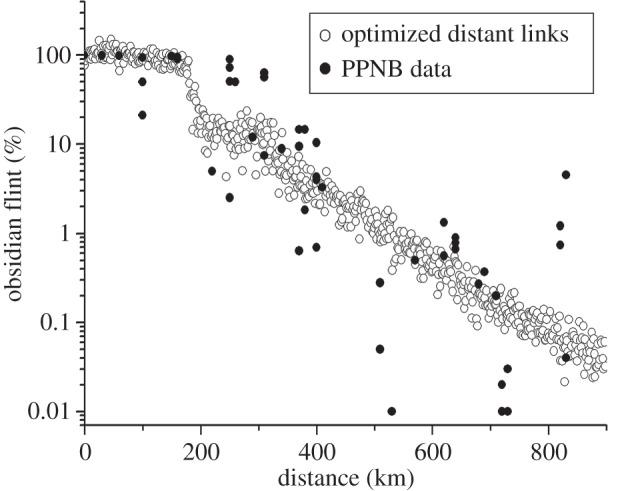
Comparison of the variability in the quantity of obsidian per village between the optimized distant link model (after 50 realizations) and the PPNB data.
Thus, a possible improvement in the distance of exchange links would have been combined with a shift in the network of exchange. During the PPNB, the tendency towards site hierarchy increased, inciting the emergence of mega-sites [37]. If we compare the mean ratio of obsidian to flint recovered from PPNB sites located more than 500 km from the obsidian sources (i.e. in the central and southern Levant), considering three site size categories (table 3), we observe that the bigger the site, the higher the proportion of obsidian it contained. These data suggest that during the PPNB, large sites played a major role in obsidian distribution networks. The efficiency in obsidian transfer needed to match PPNB data can be reached in our mathematical modelling by building from the DL model and allowing villages to improve the quality of their links by rejecting those partners that offer smaller quantities of obsidian to the benefit of those from which larger quantities of obsidian can be obtained, thus generating an ODL model. ODL partner selection provokes the preferential attachment of nodes that have access to larger quantities of obsidian (hubs), to occur as an emergent property of the model. The use of rules whereby agents are allowed to look for more advantageous partners, resulting in an optimized network where bigger trade cities tend to interconnect between themselves (a rich-get-richer effect), has been used for modelling trade in the Aegean Bronze Age [38]. In our case study, the application of similar rules results in a scenario where the interconnected nodes that possess more obsidian form the ‘core group of hubs’ of the network. The ODL model of obsidian exchange (whereby preferential attachment between obsidian suppliers is allowed) permits obsidian to reach longer distances, and matches archaeological data for the PPNB (figure 6). While the DL model cannot explain the PPNB data and an ODL model is needed, the PPNA data, which are adequately explained by a DL model with a distant link limit of 180 km, could also be explained with an ODL model with a shorter distant link limit of around 120 km (figure 9; electronic supplementary material, figure S3 in annex 2).
Table 3.
Ratio of obsidian to flint in relation to site size (small: less than 1.2 ha; medium: 1.2–5.3 ha; big: greater than 5.3 ha) at PPNB sites that are more than 500 km from obsidian sources.
| small | medium | big | all sites | |
|---|---|---|---|---|
| PPNA | 0.009 | 1.465 | (no data) | 0.233 |
| PPNB | 0.073 | 0.398 | 2.410 | 0.703 |
| all periods | 0.023 | 0.703 | 2.410 | 0.437 |
Figure 9.
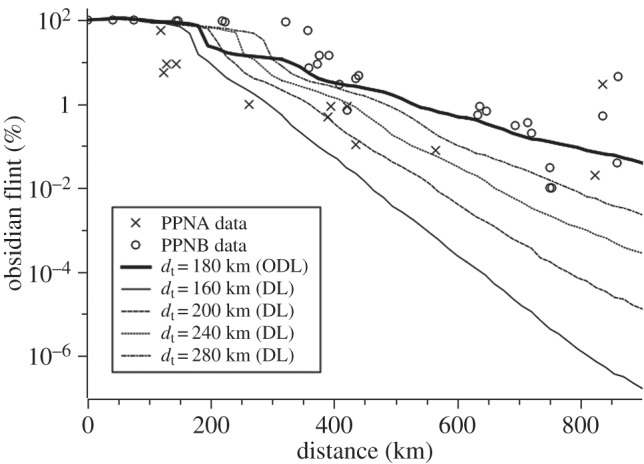
Modelling of networks resulting from the distant link model (DL) with simulations of different maximum distances of trade links compared with the modelling of the optimized distant link model (ODL) with 180 km as the maximum distance of trade links.
The ODL model results in a higher degree of site hierarchy with respect to the DL one. This can be observed in the fat-tailed histogram illustrating the distribution of the number of links per node (figure 7). In the ODL model, the cluster coefficient remains similar to the DL model, but the path length is reduced (table 2). The dispersal of these high ranked interconnected nodes or hubs in the modelled space we have created indicates that the larger hubs tend to be placed in, but are not restricted to the northern area (figure 8). As the quantity of distant links per node is directly related to the quantity of obsidian used in each village, comparing the variability in obsidian use in our model and in the PPNB data can offer an additional evaluation of the degree of compatibility between them. As can be observed in figure 10, the variability in the quantity of obsidian per site during the PPNB is even higher than in our ODL model. This suggests that other variables besides the different roles of villages in the exchange network are causing such variability in the archaeological data. The quantity and quality of local flint near these villages might explain this extreme variability because there was probably a lesser need for obsidian in areas where alternative high-quality stone could be acquired.
The comparison between our models and the archaeological data suggests that when Neolithic innovations were first being experimented with in the PPNA, a complex network of obsidian exchange developed between villages (DL model). In this network, neighbouring villages were interconnected. However, regular distant links between villages also existed. During the PPNB, this network became more complex and included a small group of interconnected sites or hubs [39] that dictated long-distance obsidian trade (ODL model). Alternatively, an ODL model could have already existed during the PPNA and the more efficient distribution of obsidian in the PPNB could be explained by an extension of the distance of the exchange links with time. The presence of an interconnected core group appears to have provided the network complexity needed for obsidian to reach further into the southern Levant. Agents exchanging between hubs could have been members of these same communities. Alternatively, certain agents could have consisted of mobile groups interacting with sedentary communities [40] as is suggested by the relatively large quantities of obsidian at seasonal or temporary campsites such as that of Nahal Lavan 109 in the Negev [41].
But was the preferential selection of exchange partners directed by a desire to obtain larger quantities of obsidian or by a desire to have better suppliers of a large variety of exotic materials, of which obsidian was one? To answer this question, we tested an obsidian exchange model using the quantity of distant partners as the criterion for selecting new partners, as opposed to the quantity of obsidian. In the former case, the selection of partners would have been directed at partners with the most numerous and most distant links, irrespective of the quantity of obsidian they had. However, because distant links are established in an isotropic way, obsidian cannot reach the southern Levant in the quantities that were present in the PPNB archaeological record using this criterion of selection. In fact, the spread of obsidian as it appeared in the PPNB can only be explained if exchange tracks are preferentially oriented along a north–south axis, joining Anatolia with the southern Levant. This can best be explained by the fact that obsidian and other northern and southern exotic materials circulating along the north–south axis were probably the major determinants in shaping the exchange network.
The dichotomy regarding local and distant exchange links which are at the base of our complex network models can be compared with ethnographic examples from New Guinea. In the case of the Irian Jaya (New Guinea), two models of acquisition of stone axes and other trade goods have been documented: one slow, local and continuous circulation associated with payments and compensations which mostly took place between allies inside the war confederation, and a quick, distant and occasional circulation for economic benefit, when shells or pigs to be obtained by exchange were needed. These expeditions of around 15 persons could take place twice a year [42]. Similar kinds of expeditions have been described in other ethnographic trade contexts, and were so common as to be described as visiting trade institutions…a sort of bridge crossing the gap between societies [43]. Competitive exchange associated with feasting can be another occasion for sporadic, substantial and distant reaching exchange [42]. A complex network comprising local, regional and intertribal trade similar to the one identified in New Guinea [44] most probably existed at the onset of the Neolithic.
5. Implications for the origins of the Near Eastern Neolithic
The application of new theoretical and methodological perspectives allows us to re-analyse obsidian exchange and to propose a more complex and realistic scenario in which distant exchange of obsidian and likely other valued objects and materials (chlorite vases, stone and shell beads, etc.) played a central role in establishing a complex network of village interaction. Some scholars have acknowledged the existence of a Neolithic interaction sphere based on the homogeneity in material culture that appeared across the Near East during the PPNB [40,45]. Our study of obsidian exchange has allowed us to quantitatively test hypotheses on its origins, modalities and impacts and to push back the emergence of this network to the very beginnings of the Neolithic (PPNA).
Though the degree of sedentarization of the last Natufian hunter–gatherers is currently under discussion, some cultural trends show that nomadic hunter–gatherers were in the process of ‘settling down’ as early as 12 000 BC. This process was accomplished in the first half of the 10th millennium BC (beginning of the PPNA) when the first sedentary villages like Jerf el Ahmar, Tell Mureybet and Jericho appeared, each hosting hundreds of people [46,47]. Living in year-round villages represented new challenges [48,49]. Restricted mobility entails a risk of isolation with respect to other groups, provoking dramatic results, as fluid intergroup interactions are crucial for the sharing of information, resources and genes. For example, the ethnographic record has provided potential analogies whereby exotic commodities are an important part of the bride price or marriage dowry. Trade and marriage relationships are closely related in New Guinea [50], where most of the marriages among Yamo horticulturalists are endogamous within their war confederation. However, some Yamo women are married to the distant Wano, and represent 25% of females married into this tribe. These arranged marriages take place in order to establish alliances assuring the stone axe supply for the Yamo [42]. Such a link between marriage and trade probably existed during the Neolithic, though it is extremely difficult to prove with the information currently available to us and without finer and larger genetic datasets on prehistoric populations. Preliminary genetic studies on several individuals recovered from graves in the Early Neolithic sites of Tell Halula (north Levant) and Tell Ramad (south Levant) have shown a common genetic pool between the two villages, which were 350 km apart from one another as the crow flies [51]. Ethnographic information suggests that most marriage transfers could have taken place at short distances (local neighbourhood) while some of them could imply longer displacements. DNA analysis indicates long-distance genetic exchange, so a leptokurtic model [52] of genetic exchange by marriage transfer would be a reasonable scenario for the period. We, therefore, hypothesize that the process of sedentarization induced human groups to establish new networks of interaction between communities through long-distance exchange of objects, ideas and genes, as a way of re-establishing or maintaining intergroup relations.
Although the emergence of long-distance trade was one of the major innovations that occurred with the onset of the Neolithic, it has played a minimal role in debates on the process of neolithization. However, the Neolithic cannot be understood without taking account of the existence of these complex networks of interaction, as these networks could explain the efficient and rapid spread of innovations across the Near East beginning in the PPNA. Some of these innovations, which included funerary rituals, plant and animal domestication, the organization of villages around collective/ritual buildings and the transition from round to square houses, appeared almost contemporaneously across an extended area of the Fertile Crescent [53,54]. The exchange of ideas and experiences which were enabled by such networks allowed human communities to be highly dynamic, while the network itself acted as a repository of innovations, reducing risks of involution [1]. The transmission of these innovations would have been slower and less reliable in a regular network of interaction. By the PPNB, the preferential attachment of a core group of villages responsible for long-distance exchange enabled a better transmission of objects and ideas, resulting in the increase of cultural similarities between farming communities and generating what has been called the ‘PPNB Civilization’.
While the intensification of interaction and cooperation facilitated by the emergence and maintenance of complex networks of exchange was not the only process contributing to the origins of the Neolithic, this was surely a necessary condition for its triggering and success. Our research has demonstrated, through compatibilities between modelling trials and the archaeological data, the viability of complex social networks in prehistoric societies and the need to look to such complex models for understanding social behaviour in the past. Complex social networking, considered a major catalyst to current innovation [55], has revealed itself to be one catalyst for the decisive cultural changes that took place around 12 000 years ago in the Near East.
Supplementary Material
Endnotes
Such a situation has been known to occur in some ethnographic examples in New Guinea, where commodities commonly used for exchange (i.e. Baruya salt or axes) [20] are massively consumed instead of traded in villages where the needs or the possibilities of exchange are limited [21].
See electronic supplementary material, annex 2 for a description and explanation of the parameters chosen in our modelling of obsidian exchange.
These features include a heavy tail in the degree distribution, a high clustering coefficient, assortativity or disassortativity among nodes, community structure and hierarchical structure.
References
- 1.Kuhn S. 2012. Emergent patterns of creativity and innovation in early technologies. In Origins of human innovation and creativity, vol. 16 (ed. Elias S.), pp. 69–87. Developments in quaternary science Amsterdam, The Netherlands: Elsevier. [Google Scholar]
- 2.Allen RC. 1984. Collective invention. J. Econ. Behav. Organ. 4, 1–24. ( 10.1016/0167-2681(83)90023-9) [DOI] [Google Scholar]
- 3.Emerson RM. 1976. Social exchange theory. Annu. Rev. Sociol. 2, 335–362. ( 10.1146/annurev.so.02.080176.002003) [DOI] [Google Scholar]
- 4.Balkan-Atli N, Binder D, Cauvin MC. 1999. Obsidian: sources, workshops and trade in Central Anatolia. In Neolithic in Turkey: the cradle of civilization: new discoveries (ed. Özdogan M.), pp. 133–145. Istanbul, Turkey: Arkeoloji ve sanat Yayinlari. [Google Scholar]
- 5.Cauvin MC, Chataigner C. 1998. Distribution de l'obsidienne dans les sites archéologiques du Proche et du Moyen Orient (par phase chronologique). In L'obsidiene au Proche et Moyen Orient: du volcan à l'outil, vol. 738 (eds Cauvin MC, Gourgaud A, Gratuze B, Arnaud NO, Poupeau G, Poidevin JL, Chataigner C.), pp. 325–350. BAR International series Oxford, UK: Archaeopress. [Google Scholar]
- 6.Cauvin MC. 2002. L’obsidienne et sa diffusion dans le Proche-Orient Néolithique. In Matériaux, productions, circulations du Néolithique à l'Age du Bronze (ed. Guilaine J.), pp. 13–30. Paris, France: Éditions Errance. [Google Scholar]
- 7.Pernicka E, Keller J, Cauvin M-C. 1997. Obsidian from Anatolian sources in the Neolithic of the middle Euphrates region (Syria). Paléorient 23, 113–122. ( 10.3406/paleo.1997.4648) [DOI] [Google Scholar]
- 8.Garfinkel Y. 2011. Obsidian distribution and cultural contacts in the southern Levant during the 7th millennium cal. BC. In The state of the stones terminologies, continuities and contexts in Near Eastern Lithics (eds Healey E, Campbell S, Maeda O.), pp. 403–409. Studies in Early Near Eastern production, subsistence, and environment Berlin, Germany: Ex Oriente. [Google Scholar]
- 9.Maeda O. 2003. Prehistoric obsidian distribution in the Rouj Basin. In Archaeology of the Rouj Basin: a regional study of the transition from village to city in northwest Syria (eds Iwasaki T, Tsuneki A.), pp. 167–184. Tsukuba, Japan: University of Tsukuba. [Google Scholar]
- 10.Chataigner C, Poidevin JL, Arnaud NO. 1998. Turkish occurrences of obsidian and use by prehistoric peoples in the Near East from 14,000 to 6,000 BP. J. Volcanol. Geotherm. Res. 85, 517–537. ( 10.1016/S0377-0273(98)00069-9) [DOI] [Google Scholar]
- 11.Bellot-Gurlet L. 1998. Caractéristaion par analyse élémentaire (PIXE et ICP-MS/-AES) d'un verre naturel: l'obsidienne. Application à l’étude de provenance d'objets archéologiques. PhD thesis, Université Joseph Fourier, Grenoble, France. [Google Scholar]
- 12.Binder D, Gratuze B, Mouralis D, Balkan-Atli N. 2011. New investigations of the Gölludag obsidian lava flows system: a multi-disciplinary approach. J. Archaeol. Sci. 38, 3174–3184. ( 10.1016/j.jas.2011.05.014) [DOI] [Google Scholar]
- 13.Gratuze B. 1998. Les méthodes de caractérisation de l'obsidienne. In L'obsidienne au Proche et Moyen Orient: du volcan à l'outil, vol. 738 (eds Cauvin MC, Gourgaud A, Gratuze B, Arnaud NO, Poupeau G, Poidevin JL, Chataigner C.), pp. 31–48. BAR International series Oxford, UK: Archaeopress. [Google Scholar]
- 14.Gratuze B. 1999. Obsidian characterization by laser ablation ICP-MS and its application to prehistoric trade in the Mediterranean and the Near East: sources and distribution of obsidian within the Aegean and Anatolia. J. Archaeol. Sci. 26, 869–881. ( 10.1006/jasc.1999.0459) [DOI] [Google Scholar]
- 15.Poidevin JL. 1998. Les gisements d'obsidienne de Turquie et de Trasncausacie: géologie, géochimie et chronométrie. In L'obsidienne au Proche et Moyen Orient: du volcan à l'outil, vol. 738 (eds Cauvin MC, Gourgaud A, Gratuze B, Arnaud NO, Poupeau G, Poidevin JL, Chataigner C.), pp. 105–156. BAR International series Oxford, UK: Archaeopress. [Google Scholar]
- 16.Renfrew C, Dixon JE, Cann JR. 1968. Further analysis of Near Eastern obsidians. Proc. Prehistoric Soc. 34, 319–331. ( 10.1017/S0079497X0001392X) [DOI] [Google Scholar]
- 17.Dillian C, White CL. 2009. Trade and exchange: archaeological studies from history and prehistory. New York, NY: Springer. [Google Scholar]
- 18.Ortega D, Ibañez JJ, Khalidi L, Méndez V, Campos D, Teira L. 2014. Towards a multi-agent-based modelling of obsidian exchange in the Neolithic Near East. J. Archaeol. Method Theory 21, 461–485. ( 10.1007/s10816-013-9196-1) [DOI] [Google Scholar]
- 19.Astruc L, Abbés E, Ibáñez-Estévez JJ, González-Urquijo J. 2003. ‘Depots’, ‘reserves’ et ‘caches’ de matériel lithique taille au Néolithique précéramique au Proche Orient: quelle gestion de l'outillage? Paléorient 29, 59–78. ( 10.3406/paleo.2003.4754) [DOI] [Google Scholar]
- 20.Godelier M. 1977. ‘Salt money’ and the circulation of commodities among the Baruya of New Guinea. In Perspectives in Marxist anthropology, pp. 127–151. Cambridge, UK: Cambridge University Press. [Google Scholar]
- 21.Lemonnier P. 1981. Le commerce inter-tribal des Anga de Nouvelle-Guinée. J. Soc. Océanistes 37, 39–75. ( 10.3406/jso.1981.3048) [DOI] [Google Scholar]
- 22.Newman MEJ. 2003. The structure and function of complex networks. SIAM Rev. 45, 167–256. ( 10.1137/S003614450342480) [DOI] [Google Scholar]
- 23.Boccaletti S, Latora V, Moreno Y, Chavez M, Hwang D-U. 2006. Complex networks: structure and dynamics. Phys. Rep. 424, 175–308. ( 10.1016/j.physrep.2005.10.009) [DOI] [Google Scholar]
- 24.Watts DJ. 2004. The ‘new’ science of networks. Annu. Rev. Sociol. 30, 243–270. ( 10.1146/annurev.soc.30.020404.104342) [DOI] [Google Scholar]
- 25.Watts DJ, Strogatz SH. 1998. Collective dynamics of ‘small-world’ networks. Nature 393, 440–442. ( 10.1038/30918) [DOI] [PubMed] [Google Scholar]
- 26.Sahlins M. 1974. Stone age economics. Chicago, IL: Aldine Publishing Company. [Google Scholar]
- 27.Rappaport RA. 1968. Pigs for the ancestors. Ritual in the ecology of a New Guinea people. A new enlarged edition New Haven, CT: Yale University Press. [Google Scholar]
- 28.Harding TG. 1967. Voyagers of the Vitiaz Strait: a study of a New Guinea trade system. Seattle, WA: University of Washington Press. [Google Scholar]
- 29.Healey CJ. 1984. Trade and sociability: balanced reciprocity as generosity in the New Guinea Highlands. Am. Ethnol. 11, 42–60. ( 10.1525/ae.1984.11.1.02a00030) [DOI] [Google Scholar]
- 30.Lauriston S. 1952. Steel axes for stone-age Australians. Hum. Organ. 11, 17–22. [Google Scholar]
- 31.Hogbin I. 1951. Transformation scene: the changing culture of a New Guinea village. London, UK: Routledge & Kegan Paul. [Google Scholar]
- 32.Heylighen F. 2008. Complexity and self-organization. In Encyclopedia of library and information sciences (eds Bates MJ, Maack MN.), pp. 1215–1224. London, UK: Taylor & Francis. [Google Scholar]
- 33.Renfrew C. 1977. Alternative models for exchange and spatial distribution. In Exchanges systems in prehistory (eds Earle TK, Ericson JE.), pp. 71–90. London, UK: Academic Press. [Google Scholar]
- 34.Garfinkel Y, Dag D. 2006. Gesher. A pre-Pottery Neolithic A site in the Central Jordan Valley, Israel. A final report. Berlin, Germany: Ex oriente. [Google Scholar]
- 35.Sevketoglu M. 2008. Early settlements and procurement of raw materials: new evidence based on research at Akanthou-Arkosykos (Tatlisu—Ciftlikdüzü), Northern Cyprus. Tüba-Ar XI, 63–72. [Google Scholar]
- 36.Helmer D, Gourichon L, Monchot H, Petersand J, Saña M. 2005. Identifying early domestic cattle from Pre-Pottery Neolithic sites on the Middle Euphrates using sexual dimorphism. In The first steps of animal domestication (eds Vigne JD, Peters J, Helmer D.), pp. 86–95. London, UK: Oxbow. [Google Scholar]
- 37.Bienert HD, Gebel HG, Neef R. (eds). 2004. Central settlements in Neolithic Jordan. Berlin, Germany: Ex Oriente. [Google Scholar]
- 38.Knappett C, Evans T, Rivers R. 2011. The Theran eruption and Minoan palatial collapse: new interpretations gained from modelling the maritime network. Antiquity 85, 1008–1023. ( 10.1017/S0003598X00068459) [DOI] [Google Scholar]
- 39.Goring-Morris AN, Belfer-Cohen A. 2014. The Southern Levant (Cisjordan) during the Neolithic Period. In The Oxford handbook of the archaeology of the Levant (ca. 8000–332 BCE) (eds Steiner ML, Killebrew AE.), pp. 141–163. Oxford, UK: Oxford University Press. [Google Scholar]
- 40.Bar-Yosef O, Belfer-Cohen A. 1989. The levantine ‘PPNB’ interaction sphere. In People and culture in change (ed. Hershkovitz I.), pp. 59–72. BAR International series, 508 Oxford, UK: Archaeopress. [Google Scholar]
- 41.Burian F, Friedman E, Mintz E. 1999. Nahal Lavan 109—a Pre-Pottery Neolithic site in the Western Negev, Israel. Festchrift für Gunter Samulla. Materialien zur von—und frühgeschichte von Hessen 8, 95–120. [Google Scholar]
- 42.Pétrequin P, Pétrequin AM. 1993. Écologie d'un outil: la hache de pierre en Irian Jaya (Indonésie). Monographie du CRA, vol. 12 Paris, France: Centre National de la Recherche Scientifique. [Google Scholar]
- 43.Heider KG. 1969. Visiting trade institutions. Am. Anthropol. 71, 462–471. ( 10.1525/aa.1969.71.3.02a00050) [DOI] [Google Scholar]
- 44.Pospisil LJ. 1963. Kapauku Papuan economy. New Haven, CT: Department of Anthropology, Yale University. [Google Scholar]
- 45.Watkins T. 2008. Supra-regional networks in the Neolithic of Southwest Asia. J. World Prehistory 21, 139–171. ( 10.1007/s10963-008-9013-z) [DOI] [Google Scholar]
- 46.Kenyon KM. 1981. Excavations at Jericho. Volume three. The architecture and stratigraphy of the Tell. London, UK: British School of Archaeology in Jerusalem. [Google Scholar]
- 47.Ibáñez JJ. (eds). 2008. Le site néolithique de Tell Mureybet (Syrie du Nord): en hommage à Jacques Cauvin. BAR International series, vol. 1843 Oxford, UK: Archaeopress. [Google Scholar]
- 48.Belfer-Cohen A, Bar-Yosef O. 2000. Early sedentism in the Near East: a bumpy ride to village life. In Life in Neolithic farming communities: social organization, identity, and differentiation (ed. Kuijt I.), pp. 19–37. New York, NY: Kluwer Academic Plenum Publishers. [Google Scholar]
- 49.Bar-Yosef O. 2001. From sedentary foragers to village hierarchies: the emergence of social institutions. In The origin of human social institutions, vol. 110 (ed. Runciman WG.), pp. 1–38. Oxford, UK: Oxford University Press. [Google Scholar]
- 50.Burton J. 1984. Axe makers of the Wahgi: precolonial industrialists of the Papua New Guinea Highlands. PhD thesis, Australian National University, Canberra, Australia. [Google Scholar]
- 51.Fernández E, Pérez-Pérez A, Gamba C, Prats E, Cuesta P, Anfruns J, Molist M, Arroyo-Pardo E, Turbón D. 2014. Ancient DNA analysis of 8000 B.C. Near Eastern farmers supports an Early Neolithic pioneer maritime colonization of mainland Europe through Cyprus and the Aegean Islands. PLoS Genet. 10, e1004401 ( 10.1371/journal.pgen.1004401) [DOI] [PMC free article] [PubMed] [Google Scholar]
- 52.Steele J. 2009. Human dispersals: mathematical models and the archaeological record. Hum. Biol. 81, 121–140. ( 10.3378/027.081.0302) [DOI] [PubMed] [Google Scholar]
- 53.Cauvin J. 2000. The birth of the gods and the origins of agriculture. Cambridge, UK: Cambridge University Press. [Google Scholar]
- 54.Wilcox G. 2005. The distribution, natural habitats and availability of wild cereals in relation to their domestication in the Near East: multiple events, multiple centres. Vegetation History Archaeobot. 14, 534–541. ( 10.1007/s00334-005-0075-x) [DOI] [Google Scholar]
- 55.Camagni RP. 1991. Technological change, uncertainty and innovation networks: towards a dynamic theory of economic space. In Regional science. Retrospect and prospect (eds Boyce DE, Nijkamp P, Shefer D.), pp. 211–249. Berlin, Germany: Springer. [Google Scholar]
Associated Data
This section collects any data citations, data availability statements, or supplementary materials included in this article.



